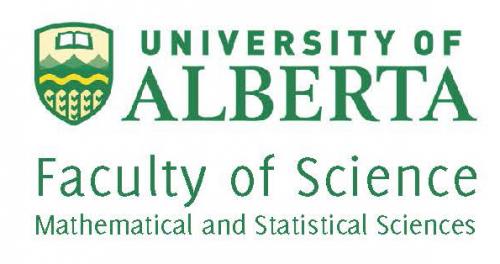Alberta Colleges Mathematics Conference and North South Dialogue in Mathematics
Topic
The Alberta Colleges Mathematics Conference presents talks about the teaching issues specific to the colleges and their math course offerings. This is an opportunity to meet with colleagues from Alberta’s post-secondary institutions primarily, discuss teaching, technology, and curriculum, and to share perspectives on experiences and common interests of mathematics in Alberta.
The North/South Dialogue, also sponsored by PIMS, will take place Friday, running concurrently with the Colleges Mathematics Conference. This year we will feature two parallel sessions (program details will follow).
Speakers
Additional Information
Location:
Campus Saint-Jean, University of Alberta
8906 rue Marie-Anne Gaboury (91 street)
Edmonton (AB) T6C 4G9
http://www.panoramio.com/photo/23951649
Registration:
There is no fee to register. To register please click "login" or "register" to create an or access your account, or click "signup" if logged in.
Accommodations:
1- The Coast Edmonton House offers special rates for the Conference. Rates starting at: $105.00 for Coast Superior Suite that can accommodate up to four people. Please refer to the PDF document linked in the image below for more details on the hotel or go to the hotel website:
http://www.roomstays.com/hotel/73128
The Campus Saint-Jean GROUP # CEH-GFC2780. Reservations should be made before April 20, 2012.
2- University of Alberta Conference Services: we also made a reservation for 40 Schaffer single private rooms & 10 hotel-style rooms for May 3-5, 2012. Reservations should be made before April 3, 2012. For the hotel-style rooms the rate is $119.00 (single or double occupancy). Add $15.00 for each additional guest – Maximum 4 people per room. For the single private rooms, the rate is $69. For more details please see the pdf linked in the image below or go to:
http://www.asinfo.ualberta.ca/ConferenceServices/Accommodation.aspx
Parking: Delegates can park in Lot 2 at Campus Saint Jean
http://www.asinfo.ualberta.ca/ParkingServices/ParkingInformation/VisitorRates.aspx
Free parking is also available on city streets around Campus Saint-Jean and at the parking lot of the Saint-Thomas d’Aquin church located at 8410 - 89 street Edmonton (AB) T6C 4N32 (walking distance from Campus Saint-Jean).
Please check back for other information. Inquiries can be directed to Dr. Hassan Safouhi at hsafouhi@ualberta.ca.
May 3rd
Dr. Jean-Marie De Koninck, Université Laval
Dr. Anna Stokke, University of Winnipeg
May 4th
Dr. Jean-Marie De Koninck, Université Laval
Dr. Robert McCann, University of Toronto
Dr. Alexander Melnikov, University of Alberta
Dr. Jean-Marie De Koninck
Biography:
Jean-Marie De Koninck is professor in the Department of mathematics and statistics at Université Laval. He is the author of 14 books and 100 publications in mathematical journals. For two years, he was the host of the television series C'est mathématique! He received the Order of Canada in 1994 as well as the Ordre national du Québec in 1999, and was named Scientist of the year 2005 by the Société Radio-Canada. He is also well known from the general public as the founder of Operation Red Nose, an awareness campaign against impaired driving to which some 55 000 volunteers participate each year.
Title: The Secret Life of Mathematics
Abstract:
Most people don't realize that mathematics is everywhere. In this talk, through a variety of examples, we will lift the veil on the secret life of mathematics.
For instance, we will show that using the famous Poisson Law in probability theory, one can establish that the team that scores the first goal in a soccer match will end up losing the game only in 14% of the cases.
In 2010, two Canadian mathematicians used an objective statistical analysis to show that teams that are trailing in a hockey game should pull their goaltender much earlier than what is common practice.
Your doctor tells you that your last blood test confirms that you have a very rare disease (only 1 out of 200 people have it); he also tells you that the test is reliable in 96% of the cases; should you be worried? According to Bayes' theorem, you should not!
We now know that the safest exits on a highway are those whose shape is that of a certain spiral.
These and other topics will demonstrate that mathematics is everywhere and therefore cannot be ignored.
Title: The mysterious world of normal numbers
Abstract:
Given an integer q>1, we say that a positive real number x is q-normal if every k-long string of digits in the base q expansion of x appears with the expected frequency, namely 1/qk. Amazingly, although one can show that almost all real numbers are normal (in the sense that the set of exceptions has Lebesgue measure zero), there is no general method that allows one to decide if a given real number is normal or not. We will first give a brief survey of the main results obtained so far on normal numbers. Then, we will show how we were able to use the complexity of the multiplicative structure of positive integers to construct large families of normal numbers.
Dr. Anna Stokke
Biography:
Anna Stokke completed a PhD in representation theory from the University of Alberta and is currently an Associate Professor at the University of Winnipeg. Recently, along with two other math professors from the University of Regina and the University of Manitoba, she co-founded the Western Initiative for Strengthening Education in Math (WISE Math). She also co-runs a Math Club for a group of Grade 4 children out of her home and is involved with running the Kangaroo Math Contest at the University of Winnipeg.
Title: What’s happening with K-12 math education?
Abstract:
Math education at the K-12 level has become a heated topic in Canada, particularly in Manitoba and Saskatchewan, over the past few months. I will discuss the main issues: teacher preparation in math and math curricula. I will detail our efforts to bring about positive changes and discuss the need for mathematicians to become involved. This lecture will be of interest to mathematicians, teachers, parents and anyone who is concerned about math education in Canada.
Dr. Robert McCann
Biography:
Robert McCann has been a Professor of Mathematics at the University of Toronto since 1998. Over the last twenty years, he has lead the development of the theory of optimal transportation, pioneering applications both within and outside mathematics. The displacement convexity from his 1994 PhD has played a major role in unifying our understanding of many geometry and analytic inequalities. His study of optimal mappings in the Euclidean and Riemannian settings has led to notions Ricci curvature bounds for metric measure spaces. With his collaborators, he was amongst the first to solve Monge's (1781) problem concerning existence of optimal maps, and to use optimal transportation to study contractivity of infinite dimensional dynamical systems expressed by partial differential equations. He was also the first to appreciate the role of the geometry and topology of the cost function in determining the uniqueness of optimal joint measures and the smoothness of optimal maps, and he has applied this theory to problems ranging from ocean eddy modeling to optimal pricing.
Title:Geometric Variational Problems in Economics
Abstract:
Geometry and economics have interacted very little over the last fifty years. They are likely to interact very substantially over the next fifty years. This talk will describe some surprising recent interactions between geometry and economics.
The monopolist's problem, for example, consists of deciding what types of products to manufacture and how much to charge for each of them, knowing only statistical information about the preferences of an anonymous field of potential buyers. It is one of the basic problems analyzed in economic theory. The solution to this problem when the space of products and of buyers can each be parameterized by a single variable (say quality X, and income Y) garnered Mirrlees (1971) and Spence (1974) their Nobel prizes in 1996 and 2001.
The multidimensional version of this question is a largely open problem in geometric analysis.
I will describe recent work with A Figalli and Y-H Kim, identifying structural conditions on the value b(X,Y) of product X to buyer Y which reduce this problem to a convex program in a Banach space --- leading to uniqueness and stability results for its solution, confirming robustness of certain economic phenomena such as the desirability for the monopolist to raise prices enough to drive a positive fraction of buyers out of the market, and yielding conjectures about the robustness of other phenomena, such as the clumping together of products marketed into subsets of various dimension.
The passage to several dimensions relies on ideas from differential geometry / general relativity, optimal transportation, and nonlinear partial differential equations.
Dr. Alexander Melnikov

Biography:
Alexander Melnikov is a Professor (Mathematical Finance) at the University of Alberta. He joined to the UofA in 2001 working before in the Steklov Mathematical Institute of Russian Academy of Sciences where he did outstanding contributions to Stochastic Analysis, Statistics of Random Processes and Mathematical Finance. Dr. Melnikov’s main research endeavors’ involves the application of Mathematical Finance to Insurance and Risk-Management. He developed imperfect hedging techniques for different financial markets and was the first who applied this apparatus to pricing of equity-linked life insurance contracts, an innovative area of research and applications. These studies are also reflected in his monographs “Mathematics of Financial Obligations” and “Risk Analysis in Finance and Insurance”. In recognition of these achievements Dr. Melnikov was elected a fellow of the Russian Academy of Natural Sciences, and was awarded the Leontiev (Nobel Price Winner) medal “For Achievements in Economics” of this Academy.
Title:On Quantitative Risk Management in Equity-Linked Life Insurance
Abstract:
In the talk we study equity-linked life insurance contracts with fixed and stochastic guarantees linked to the evolution of a financial market. The presence of a client’s mortality risk does not allow perfect hedging, and we utilize imperfect hedging methodologies. These methodologies were developed in mathematical finance based on loss function conceptions (quantile and efficient hedging) and risk measures. We allow an insurance company to be exposed to a financial risk. The price of the contracts will be subject to a maximization/minimization of the expected loss function/risk measure under initial budget constraints. In the Black-Scholes and jump-diffusion setting we derive equations separating financial and insurance risks embedded in the contracts and propose a methodology for effective risk-management of the contracts. Pooling homogeneous clients together enables the insurance company to take advantage of diversification of a mortality risk. A large enough portfolio of life insurance contracts will result in a more predictable mortality exposure and reduced prices. The results will be illustrated with the help of financial indices (S&P 500 and the Russell 2000).






